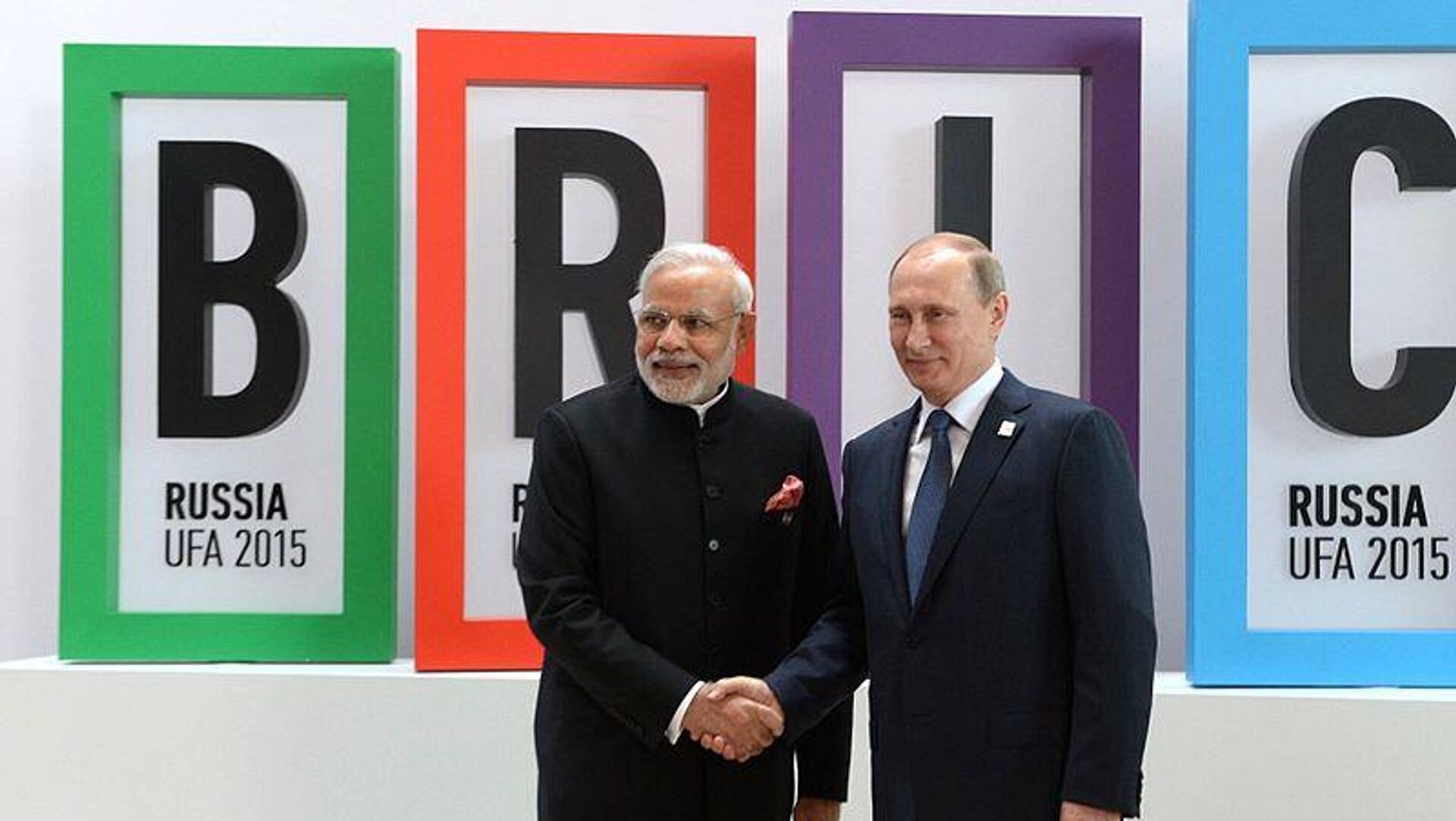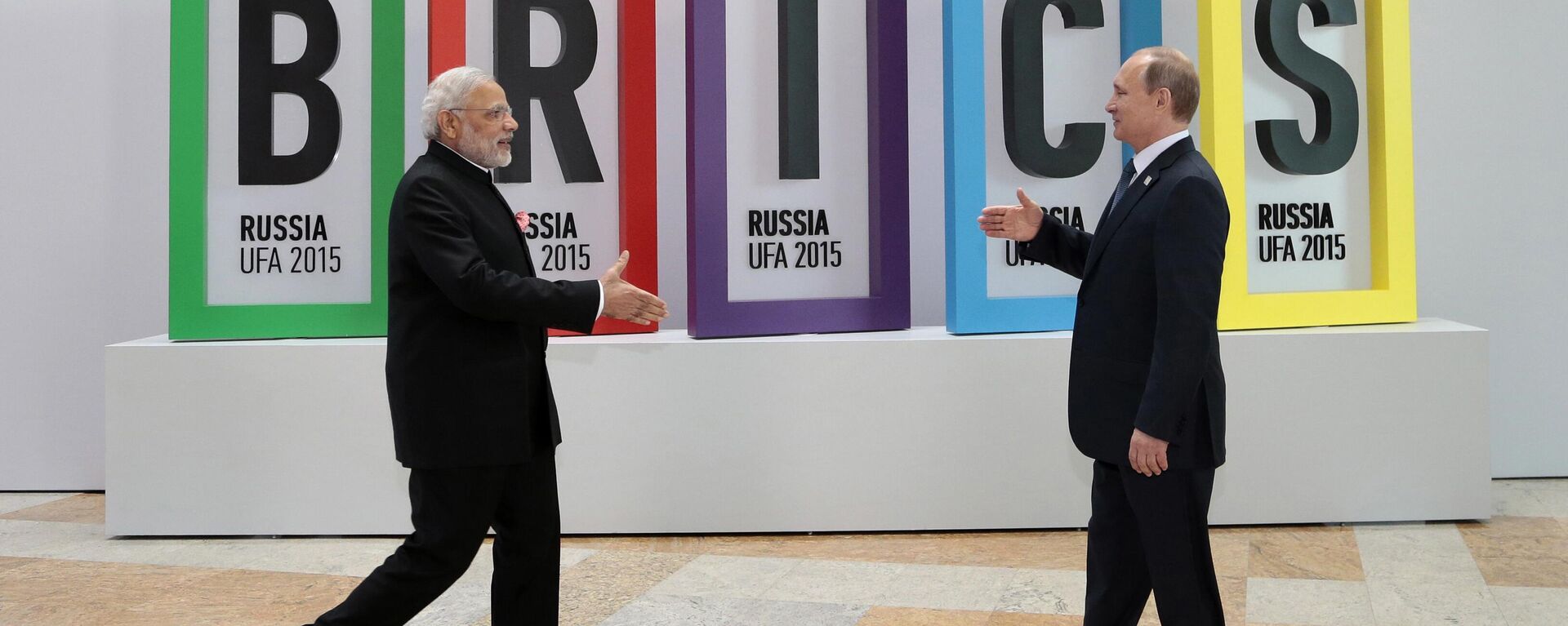https://sputniknews.in/20240613/brics-economic-significance-for-india-projected-to-increase-in-modi-30-7607790.html
BRICS' Economic Significance for India Projected to Increase in Modi 3.0
BRICS' Economic Significance for India Projected to Increase in Modi 3.0
Sputnik India
BRICS has an important role to play in India's economic trajectory during Prime Minister Narendra Modi's third term in office as the leader seeks to advance the South Asian nation into the world's third-biggest economy by 2029.
2024-06-13T17:55+0530
2024-06-13T17:55+0530
2024-06-13T17:55+0530
sputnik opinion
narendra modi
india
russia
china
brics
bharatiya janata party (bjp)
youth unemployment
unemployment
ladakh
https://cdn1.img.sputniknews.in/img/07e8/06/0d/7611054_0:0:800:451_1920x0_80_0_0_c6ee01f90a340630b8f50d46dcb95e4e.jpg
BRICS has an important role to play in India's economic trajectory during Prime Minister Narendra Modi's third term in office as the leader seeks to advance the South Asian nation into the world's third-biggest economy by 2029, according to a former senior Indian Ambassador.The veteran diplomat, presently, a Distinguished Fellow at Mumbai-based think tank Gateway House, stated that four of India's top five trading partners barring the US – China, Russia, the United Arab Emirates (UAE) and Saudi Arabia – were members of the BRICS grouping or have formally agreed to join the non-western economic bloc.While there were "national security" concerns in India on the question of whether to expand economic and investment cooperation with China in view of the Ladakh border standoff, Bhatia noted that New Delhi has kept its bilateral differences from Beijing separate from multilateral cooperation.The expert's comments come days after the BRICS Foreign Ministers' Meeting in the city of Nizhny Novogorad under the Russian presidency.Bhatia further underscored that economic cooperation was one of three main "pillars" of BRICS, adding that its success was exemplified by the fact that the organisation has overtaken the G7 bloc in collective economic heft (in terms of Purchasing Power Parity).BRICS: A Major Source of Energy Imports for IndiaMeanwhile, Bhatia highlighted that BRICS countries were also a major source of energy imports for India, be it petrol or Liquefied Natural Gas (LNG).Since last year, Russia has consistent ranked as the state's biggest source of crude oil amid a global volatility in crude markets. India is the third-biggest consumer of crude, meeting around 85% of its requirements through imports.At the same time, the country's energy partnership with the UAE has been on the upswing, with the signing of the long-term gas agreement between Abu Dhabi National Oil Company (ADNOC) and Gas Authority of India Limited (GAIL) in January.Moreover, both Prime Minister Modi and UAE Mohamed bin Zayed Al Nahyan hailed a "new era in the energy partnership" at a February meeting in Abu Dhabi.Opportunities for BRICSMeantime, veteran Ambassador Bhatia noted that one of the sectors with a "huge potential" of intra-BRICS cooperation was the micro, medium and small enterprises (MSMEs), which is the second-biggest employer in India after the agriculture industry.He added that Russia and India were already actively promoting engagements in the MSME sector.Signals from the West on Modi's Election VictoryWhile the western media was generally jubilant over India's election results in view of a reduced majority of Prime Minister Narendra Modi's Bharatiya Janata Party (BJP), certain western commentators have also predicted that a coalition government would affect the liberalisation process of the economy, particularly agriculture, labour and the further opening up of industries to attract foreign investors.The Economist, for instance, stated in a column this week that Modi could expand the scope of welfare payments, which would require increased "fiscal room" and diversion of funds from infrastructure investments among others.In fact, the first decisions that Modi took a day after being sworn-in as Prime Minister on 9 June was to sanction the direct bank account transfers to the tune of $2.3 billion to nearly 93 million Indian farmers under the PM Kisan Nidhi Scheme. During his first cabinet meeting this week, Modi also approved federal assistance for the construction of 30 million homes for the poor under Pradhan Mantri Awas Yojana (PMAY).However, Washington-DC based think tank Atlantic Council predicts that Modi 3.0 would "face challenges both abroad and at home" as it's keen on to maintain the onsistent economic growth of around 7% annually.Nevertheless, in his previous terms, the Modi government was viewed as courting foreign investors in order to ramp up the country's own domestic manufacturing capacity, create jobs for the world's biggest youth population as well as advance capabilities in emerging and critical sectors such as Artificial Intelligence (AI), semi-conductors, etc.In March, India signed its first free trade pact with the West (European Free Trade Association), which includes a commitment of $100 billion in investments over the next 15 years: USA (9%), Netherland (7%) and Japan (6%) were among the top five countries for FDI equity inflows into India last year, according to Invest India Agency.However, Indian policymakers have remained concerned about West's politicisation of human rights to advance its political agenda, as well as linking of this twisted human rights' narrative with investments.
https://sputniknews.in/20240611/modi-will-attend-the-brics-summit-in-kazan-confirms-indian-delegation-head-7589863.html
india
russia
china
ladakh
uae
the united arab emirates (uae)
us
Sputnik India
feedback.hindi@sputniknews.com
+74956456601
MIA „Rossiya Segodnya“
2024
Dhairya Maheshwari
https://cdn1.img.sputniknews.in/img/07e6/0c/13/138962_0:0:641:640_100x100_80_0_0_2cb44360dbcdf6d84bf4b299cd045917.jpg
Dhairya Maheshwari
https://cdn1.img.sputniknews.in/img/07e6/0c/13/138962_0:0:641:640_100x100_80_0_0_2cb44360dbcdf6d84bf4b299cd045917.jpg
News
en_IN
Sputnik India
feedback.hindi@sputniknews.com
+74956456601
MIA „Rossiya Segodnya“
Sputnik India
feedback.hindi@sputniknews.com
+74956456601
MIA „Rossiya Segodnya“
Dhairya Maheshwari
https://cdn1.img.sputniknews.in/img/07e6/0c/13/138962_0:0:641:640_100x100_80_0_0_2cb44360dbcdf6d84bf4b299cd045917.jpg
brics expansion, brics dedollarisation, brics russia, brics summit, modi news, modi speech, putin news, putin speech, g7 summit italy, modi g7 summit, indian economy, india inflation, india unemployment, russian oil exports, russian exports, russia india ties, india china ties, india china border standoff, uae india cepa, india lng imports, brics foreign ministers meeting, india unemployment
brics expansion, brics dedollarisation, brics russia, brics summit, modi news, modi speech, putin news, putin speech, g7 summit italy, modi g7 summit, indian economy, india inflation, india unemployment, russian oil exports, russian exports, russia india ties, india china ties, india china border standoff, uae india cepa, india lng imports, brics foreign ministers meeting, india unemployment
BRICS' Economic Significance for India Projected to Increase in Modi 3.0
The BRICS Foreign Ministers this week doubled down on calls for reforms of the global financial and political architecture, increased use of national currencies even as they criticised "unilateral coercive" measures and other policies distorting the level playing field.
BRICS has an important role to play in India's economic trajectory during Prime Minister Narendra Modi's third term in office as the leader seeks to advance the South Asian nation into the world's third-biggest economy by 2029, according to a former senior Indian Ambassador.
"BRICS ranks high in terms of priorities in India's foreign policy, probably among top of all the multilateral groupings that it is a part. The economic significance of BRICS for India has only increased with the addition of new members," Rajiv Bhatia, an ex-envoy to South Africa and Myanmar told Sputnik India.
The veteran diplomat, presently, a
Distinguished Fellow at Mumbai-based think tank Gateway House, stated that four of India's top five trading
partners barring the US – China, Russia, the United Arab Emirates (UAE) and Saudi Arabia – were members of the
BRICS grouping or have formally agreed to join the non-western economic bloc.
While there were "national security" concerns in India on the question of whether to expand economic and investment cooperation with China in view of the Ladakh border standoff, Bhatia noted that New Delhi has kept its bilateral differences from Beijing separate from multilateral cooperation.
"India shares the BRICS' goal of advancing a multipolar world order," he remarked.
The expert's comments come days after the
BRICS Foreign Ministers' Meeting in the city of Nizhny Novogorad under the Russian presidency.
Bhatia further underscored that economic cooperation was one of three main "pillars" of BRICS, adding that its success was exemplified by the fact that the organisation has overtaken the G7 bloc in collective economic heft (in terms of Purchasing Power Parity).
BRICS: A Major Source of Energy Imports for India
Meanwhile, Bhatia highlighted that BRICS countries were also a major source of energy imports for India, be it petrol or Liquefied Natural Gas (LNG).
Since last year,
Russia has consistent ranked as the state's
biggest source of crude oil amid a global volatility in crude markets. India is the third-biggest consumer of
crude, meeting around 85% of its requirements through imports.
At the same time, the country's energy partnership with the UAE has been on the upswing, with the signing of the long-term gas agreement between Abu Dhabi National Oil Company (ADNOC) and Gas Authority of India Limited (GAIL) in January.
Moreover, both Prime Minister Modi and UAE Mohamed bin Zayed Al Nahyan hailed a "new era in the energy partnership" at a February meeting in Abu Dhabi.
Meantime, veteran Ambassador Bhatia noted that one of the sectors with a "huge potential" of
intra-BRICS cooperation was the micro, medium and small enterprises (MSMEs), which is the second-biggest employer in India after the agriculture industry.
"The smallest and the biggest companies usually get government support in terms of subsidies and Production Linked-Incentives for big projects. The MSMEs are usually left to fend for themselves," Bhatia said.
Signals from the West on Modi's Election Victory
While the
western media was generally jubilant over India's election results in view of a reduced majority of Prime Minister Narendra Modi's Bharatiya Janata Party (BJP), certain western commentators have also predicted that a coalition government would affect the liberalisation process of the economy, particularly agriculture, labour and the further opening up of industries to attract foreign investors.
The Economist, for instance, stated in a column this week that Modi could expand the scope of welfare payments, which would require increased "fiscal room" and diversion of funds from infrastructure investments among others.
In fact, the first decisions that Modi took a day after being sworn-in as Prime Minister on 9 June was to sanction the direct bank account transfers to the tune of $2.3 billion to nearly 93 million Indian farmers under the PM Kisan Nidhi Scheme. During his first cabinet meeting this week, Modi also approved federal assistance for the construction of 30 million homes for the poor under Pradhan Mantri Awas Yojana (PMAY).
However, Washington-DC based think tank Atlantic Council predicts that Modi 3.0 would "face challenges both abroad and at home" as it's keen on to maintain the onsistent economic growth of around 7% annually.
"To name just one example, the United States and Europe ramping up their industrial policies could dampen manufacturing growth in India by limiting foreign direct investment and exports," the organisation's report reads.
Nevertheless, in his previous terms, the Modi government was
viewed as courting foreign investors in order to ramp up the country's own domestic manufacturing capacity, create jobs for the world's biggest youth population as well as advance capabilities in emerging and critical sectors such as Artificial Intelligence (AI), semi-conductors, etc.
In March, India signed its first free trade pact with the West (European Free Trade Association), which includes a commitment of $100 billion in investments over the next 15 years: USA (9%), Netherland (7%) and Japan (6%) were among the top five countries for FDI equity inflows into India last year, according to Invest India Agency.
Addressing a press conference ahead of Modi's departure for the G7 Summit in Italy, his first foreign trip in his third term, Foreign Secretary Vinay Kwatra during a press-conference emphasised that collaboration with G7 countries was important in view of "developing India's economic, technological, and investment sectors".
However, Indian policymakers have remained concerned about West's politicisation of human rights to advance its political agenda, as well as linking of this twisted human rights' narrative with investments.



